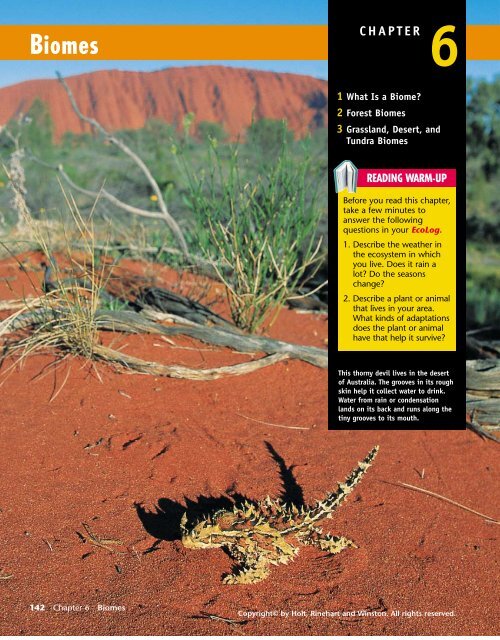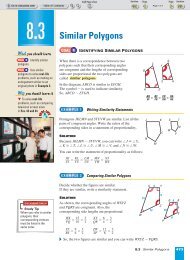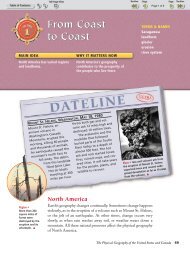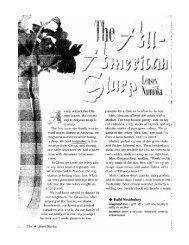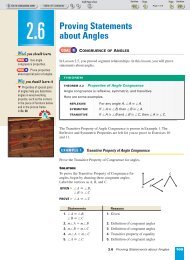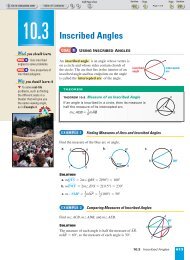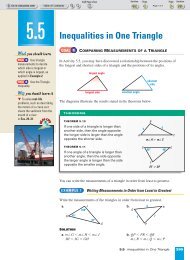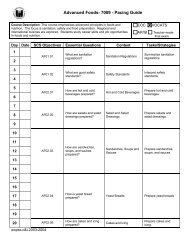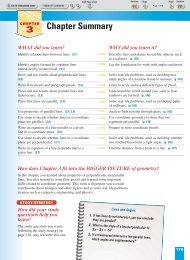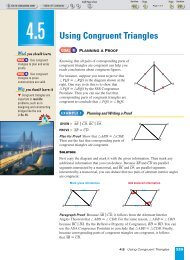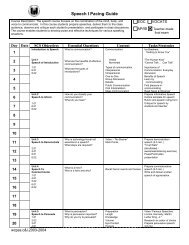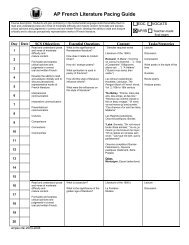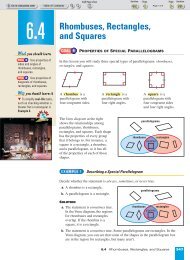Section 1 What Is a Biome? - Nexuslearning.net
Section 1 What Is a Biome? - Nexuslearning.net
Section 1 What Is a Biome? - Nexuslearning.net
Create successful ePaper yourself
Turn your PDF publications into a flip-book with our unique Google optimized e-Paper software.
<strong>Biome</strong>s<br />
142 Chapter 6 <strong>Biome</strong>s<br />
CHAPTER<br />
1 <strong>What</strong> <strong>Is</strong> a <strong>Biome</strong>?<br />
2 Forest <strong>Biome</strong>s<br />
3 Grassland, Desert, and<br />
Tundra <strong>Biome</strong>s<br />
6<br />
READING WARM-UP<br />
Before you read this chapter,<br />
take a few minutes to<br />
answer the following<br />
questions in your EcoLog.<br />
1. Describe the weather in<br />
the ecosystem in which<br />
you live. Does it rain a<br />
lot? Do the seasons<br />
change?<br />
2. Describe a plant or animal<br />
that lives in your area.<br />
<strong>What</strong> kinds of adaptations<br />
does the plant or animal<br />
have that help it survive?<br />
This thorny devil lives in the desert<br />
of Australia. The grooves in its rough<br />
skin help it collect water to drink.<br />
Water from rain or condensation<br />
lands on its back and runs along the<br />
tiny grooves to its mouth.<br />
Copyright© by Holt, Rinehart and Winston. All rights reserved.
SECTION 1<br />
<strong>What</strong> <strong>Is</strong> a <strong>Biome</strong>?<br />
Earth is covered by many types of ecosystems. Ecologists group<br />
these ecosystems into larger areas known as biomes. A biome is a<br />
large region characterized by a specific type of climate and certain<br />
types of plants and animal communities. Each biome is made up<br />
of many individual ecosystems. The map in Figure 1 shows the<br />
locations of the world’s major land, or terrestrial, biomes. In this<br />
chapter, you will take a tour through these terrestrial biomes—<br />
from lush rain forests to scorching deserts and the frozen tundra.<br />
When you read about each biome, notice the adaptations that<br />
organisms have to their very different environments.<br />
<strong>Biome</strong>s and Vegetation<br />
<strong>Biome</strong>s are described by their vegetation because plants that grow<br />
in an area determine the other organisms that can live there. For<br />
example, shrubs called rhododendrons grow in northern temperate<br />
forests because they cannot survive high temperatures. However,<br />
mahogany trees grow in tropical rain forests because they<br />
cannot survive cold, dry weather. Organisms that depend on<br />
mahogany trees will live where mahogany trees grow.<br />
Plants in a particular biome have characteristics, specialized<br />
structures, or adaptations that allow the plants to survive in that<br />
biome. These adaptations include size, shape, and color. For<br />
example, plants that grow in the tundra tend to be short because<br />
they cannot obtain enough water to grow larger. They also have a<br />
short summer growing season, while desert plants, such as cactuses,<br />
do not have leaves. Instead, cactuses have specialized structures<br />
to conserve and retain water.<br />
Copyright© by Holt, Rinehart and Winston. All rights reserved.<br />
Objectives<br />
Describe how plants determine<br />
the name of a biome.<br />
Explain how temperature and<br />
precipitation determine which<br />
plants grow in an area.<br />
Explain how latitude and altitude<br />
affect which plants grow in an area.<br />
Key Terms<br />
biome<br />
climate<br />
latitude<br />
altitude<br />
Figure 1 The ecosystems of the<br />
world can be grouped into regions<br />
called biomes. These biomes shown<br />
below are named for the vegetation<br />
that grows there.<br />
<strong>Section</strong> 1 <strong>What</strong> <strong>Is</strong> a <strong>Biome</strong>? 143
Figure 2 Plants in the tundra<br />
biome, such as those shown above,<br />
are usually short because the soil is<br />
frozen most of the year, which prevents<br />
the plants from obtaining<br />
much water.<br />
Figure 3 Temperature and precipitation<br />
help determine the type of<br />
vegetation in an ecosystem. As temperature<br />
and precipitation decrease,<br />
the climate of an area becomes drier<br />
and vegetation becomes sparser.<br />
Hot<br />
144 Chapter 6 <strong>Biome</strong>s<br />
<strong>Biome</strong>s and Climate<br />
<strong>Biome</strong>s are defined by their plant life, but what factors determine<br />
which plants can grow in a certain area? The main factor is cli-<br />
mate. Climate refers to the weather conditions, such as tempera-<br />
ture, precipitation, humidity, and winds, in an area over a long<br />
period of time. Temperature and precipitation are the two most<br />
important factors that determine a region’s climate.<br />
Temperature and Precipitation The climate of a biome is determined<br />
by average temperature and precipitation. Most organisms<br />
are adapted to live within a particular range of temperatures and<br />
will not survive at temperatures too far above or below their range.<br />
Precipitation also limits the organisms that are found in a<br />
biome. All organisms need water, and the larger an organism is,<br />
the more water it needs. For example, biomes that do not receive<br />
enough rainfall to support large trees support communities dominated<br />
by small trees, shrubs, and grasses. In biomes where rainfall<br />
is not frequent, the vegetation is made up of mostly cactuses<br />
and desert shrubs. The plants in Figure 2 grow close to the<br />
ground in the tundra because there is not enough water to support<br />
larger plants and trees. In extreme cases, lack of rainfall<br />
results in no plants, no matter what the temperature is. As shown<br />
in Figure 3, the higher the temperature and precipitation are, the<br />
taller and denser the vegetation is. Notice how much more vegetation<br />
exists in a hot, wet tropical rain forest than in a dry desert.<br />
Tundra<br />
Taiga<br />
Arctic<br />
Subarctic<br />
Temperate forest Temperate grassland<br />
Desert<br />
Temperate<br />
Tropical rain forest Savanna<br />
Desert<br />
Wet<br />
Decreasing temperature<br />
Cold<br />
Decreasing precipitation<br />
Dry<br />
Tropical<br />
Copyright© by Holt, Rinehart and Winston. All rights reserved.
Latitude and Altitude <strong>Biome</strong>s, climate, and vegetation vary<br />
with latitude and altitude. Latitude is the distance north or<br />
south of the equator and is measured in degrees. Altitude is the<br />
height of an object above sea level. Climate varies with latitude<br />
and altitude. For example, climate gets colder as latitude and<br />
altitude increase. So, climate also gets colder as you move farther<br />
up a mountain.<br />
Figure 4 shows that as latitude and altitude increase, biomes<br />
and vegetation change. For example, the trees of tropical rain<br />
forests usually grow closer to the equator, while the mosses and<br />
lichens of the tundra usually grow closer to the poles. The land<br />
located in the temperate region of the world, between about 30°<br />
and 60° north latitude and 30° and 60° south latitude, is where<br />
most of the food in the world is grown. This region includes biomes<br />
such as temperate forests and grasslands, which usually have<br />
moderate temperatures and fertile soil that is ideal for agriculture.<br />
SECTION 1 Review<br />
1. Describe how plants determine the name of a<br />
biome.<br />
2. Explain how temperature affects which plants grow<br />
in an area.<br />
3. Explain how precipitation affects which plants grow<br />
in an area.<br />
4. Define latitude and altitude. How is latitude different<br />
from altitude? How do these factors affect the organisms<br />
that live in a biome?<br />
Copyright© by Holt, Rinehart and Winston. All rights reserved.<br />
Figure 4 Latitude and altitude<br />
affect climate and vegetation in<br />
a biome.<br />
www.scilinks.org<br />
Topic: <strong>Biome</strong>s<br />
SciLinks code: HE4007<br />
CRITICAL THINKING<br />
5. Making Inferences The equator passes through<br />
the country of Ecuador. But the climate in Ecuador<br />
can range from hot and humid to cool and dry. Write<br />
a short paragraph that explains what might cause this<br />
range in climate. WRITING SKILLS<br />
6. Analyzing Relationships Look at Figure 1, and<br />
locate the equator and 30° north latitude. Which<br />
biomes are located between these two lines?<br />
<strong>Section</strong> 1 <strong>What</strong> <strong>Is</strong> a <strong>Biome</strong>? 145


